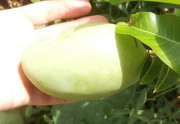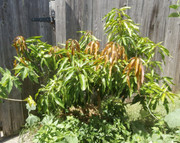I have a seedling growth tree that gave me 1 very tasty fruit.
i cant be sure of the parentage. i was told it was Florigon
but, when i posted it here last year, someone told me it didnt look like Florigon.
I can say, the fruit was good.
Not overly complex, and the flesh to seed ratio wasnt the best
but, it wasnt a bad tasting mango.
I dont think it was over 3 yrs from seed to fruit if i remember right.
Sadly, this Jan we had 1 night of a hard freeze
and it died back to almost the roots.
it is slowly growing back.
One problem i am having, is the limbs extend and bend under thier own weight
2 of them now are laying on the ground
Last year before the frost...

